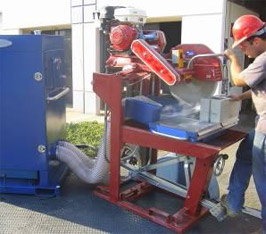Silica safety:
Introduction:
Crystalline silica is an important industrial material found abundantly in the earth’s crust. It is a mineral that occurs in several forms. Quartz, the most common form, is a component of sand, stone, rock, concrete, brick, block, and mortar. Many of these materials are used every day across a wide variety of industrial settings, including construction, mining, manufacturing, maritime, and agriculture.
Occupational exposure to crystalline silica often occurs as part of common workplace operations involving cutting, sawing, drilling, and crushing of concrete, brick, block, rock, and stone products (such as in construction work). Operations using sand products (such as glass manufacturing, foundries, and sand blasting) can result in worker inhalation of small (respirable) crystalline silica particles from the air.These types of exposures can lead to the development of disabling and some times fatal lung diseases, including silicosis and lung cancer. Processes historically associated with high rates of silicosis include sandblasting, sand-casting foundry operations, mining, tunneling, cement cutting and demolition, masonry work, and granite cutting.
This page offers guidance that may be useful to workers and employees across a number of industries. Resources for general industry and construction are highlighted where appropriate
OSHA regulations for occupational exposure to crystalline silica are addressed in specific standards for general industry, shipyard employment, and the construction industry.
General Industry
Shipyard Employment
- Mechanical paint removers
- Air contaminants
Construction Industry
- Gases, vapors, fumes, dusts, and mists
- Gases, vapors, fumes, dusts, and mists
- Ventilation
Silica Hazardous?
Silica, often referred to as quartz, is a very common mineral. It is found in many materials common on construction sites, including soil, sand, concrete, masonry, rock, granite, and landscaping materials.
The dust created by cutting, grinding, drilling or otherwise disturbing these materials can contain crystalline silica particles. These dust particles are very small. You cannot see them. This respirable silica dust causes lung disease and lung cancer. It only takes a very small amount of airborne silica dust to create a health hazard.
Recognizing that very small, respirable silica particles are hazardous, the Occupational Safety and Health Administration (OSHA) regulation 29 CFR 1926.55(a) requires construction employers to keep worker exposures at or below a Permissible Exposure Level (PEL) of 0.1 mg/m3 (click here to learn more about the PEL). The National Institute for Occupational Safety and Health (NIOSH) has a lower Recommended Exposure Level (REL) of 0.05 mg/m3.
Permissible Exposure Limits for Silica: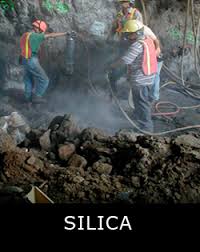
OSHA regulates silica exposure using the permissible exposure limit (PEL), which is the maximum amount of airborne dust an employee may be exposed to during a full work shift.
The PEL is dependent on the amount of crystalline silica that is present in the dust. The equation for this calculation is given below. For the most part, OSHA is more concerned with the respirable fraction of the sample because it is more hazardous; however, both respirable and total dust equations are shown. The following parameters are necessary to calculate the PEL and the exposure level.
- % crystalline silica in the air samples (if the laboratory reports the silica concentrations in units of mass convert the mass to percent - e.g., [sample weight (mg) ÷ dust weight (mg) ] × 100% ):
- % quartz
- % cristobalite
- % tridymite
- Total weight of the dust collected in the air samples in milligrams.
- Total volume of air sampled for each sample in cubic meters (1000 liters = 1 cubic meter).
- Total sampling time for each air sample in minutes.
What are the possible exposure sources?
Crystalline silica can be found in certain types of natural materials, such as:
- Sand
- Soil and rock
- Gravel
- Sandstone
- Slate
- Granite
- Clay
Typical construction materials made from these natural ingredients include:
- Ceramic and terracotta tiles
- Concrete and concrete block
- Manufactured stone
- Roof tiles
- Bricks and blocks
- Grouts and mortar
- Some joint compounds
- Abrasive materials
These become some of the sources of exposure associated with a number of the construction trades.
Exposure Levels:
Airborne exposure to crystalline silica dust can depend on a number of things, such as:
1. Types of activities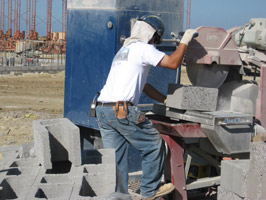
- Cutting, drilling and coring
- Concrete
- Roof tile
- Tile backer board
- Brick and block
- Granite
- Grinding, Sanding and Sandblasting
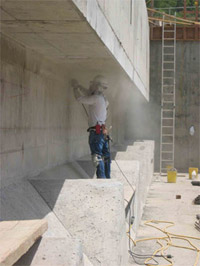
- Sack and patch
- Tuck point grinding
- Scabbing/scarifying
- Drywall mud sanding
- Hand-held surface grinding
- Pulverizing
- Jack and chipping hammers
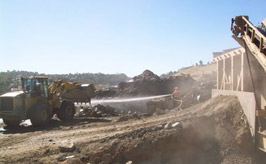
- Cement truck cleaning
- Concrete recycling
- Road milling
- Backhoes, excavators
- Demolition
- Jack and chipping hammers
- Mixing (dry)
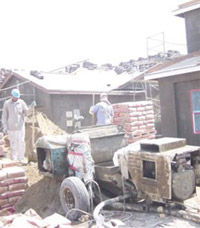
- Cement
- Plaster and grout
- Cleaning up
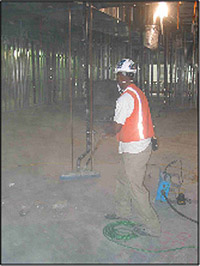
- Dry sweeping (versus wet)
- Compressed air (versus vacuum)
- Hauling
2. Location
- Outside or in a wide open area versus inside or an enclosed area
3. Materials being used
- The percentage of silica present varies a lot. The higher the content, the more likely overexposure will occur
4. Types of equipment used
- Cutting using wet methods versus dry methods
- Types of blades or abrasives used
- Use of local ventilation that prevents or reduces the amount of dust you breathe
5. How long the dust-generating activity goes on in a shift
- The longer the duration of exposure, the greater the chance of overexposure
6. Weather conditions
- Presence of moisture
- The lighter the wind the less likely airborne dust generated will move away from the breathing zone and be quickly diluted. On the flip side, wind currents can move the hazard away from one person to another.

Allowable Exposure Levels: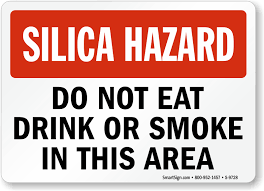
Cal/OSHA has established regulatory permissible exposure levels for silica that varies depending on the form of silica (quartz, fused, tripoli, tridymite and cristobolite) and particle sizes present. These allowable exposure levels are reflective of an employee's average exposure throughout an 8-hour shift. There is a difference between "total" and "respirable" silica dust, in that "respirable" silica dust is more likely to get into the deep parts of the lungs and cause more serious damage.
Cal/OSHA's Permissible Exposure Levels over an 8-hour average basis
- Respirable crystalline silica (quartz, fused, tripoli), 0.1 mg/m3 - 0.1 milligrams of Silica in 1 cubic meter of air.
- Total crystalline silica (quartz), 0.3 mg/m3.
- Respirable cristobolite and tridymite, 0.05 mg/m3.
Who’s At Risk?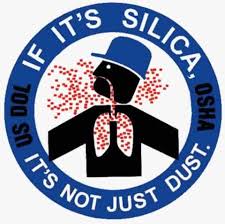
Each year, hundreds of workers die from illnesses caused by breathing in silica and thousands more become ill.
Any construction worker who performs one or more of the following tasks with any of the materials listed below is at risk of being exposed to hazardous levels silica dust. If you work close by someone generating silica dust you may be at risk.
Task Construction Material
- Abrasive blasting Asphalt (for paving)
- Bush hammering Brick
- Cutting/sawing Cement
- Demolishing/disturbing Concrete
- Drilling Concrete Block
- Earth moving Drywall
- Grinding Jack Fiber Cement products
- hammering Grout
- Milling Paints containing silica
- Mixing Gunite/Shot crete
- Polishing Mortar
- Roofing Plaster
- Sacking/patching Refractory Mortar/Castables
- Sanding Refractory Units
- Scabbing Rock
- Scarifying Roofing tiles & paves
- Scraping Sand
- Sweeping/cleaning up Soil (fill dirt and top soil)
What are the Health Effects?
Inhaling crystalline silica can lead to serious, sometimes fatal illnesses including silicosis, lung cancer, tuberculosis (in those with silicosis), and chronic obstructive pulmonary disease (COPD). In addition, silica exposure has been linked to other illnesses including renal disease and other cancers.
Inhalation of respirable crystalline silica particles has long been known to cause silicosis, a disabling, non-reversible and sometimes fatal lung disease. Respirable crystalline silica also causes lung cancer. The International Agency for Research on Cancer has designated crystalline silica as carcinogenic to humans, and the U.S. National Toxicology Program has concluded that respirable crystalline silica is known to be a human carcinogen. The National Institute for Occupational Safety and Health (NIOSH) has also recommended that respirable crystalline silica be considered a potential occupational carcinogen. In addition, exposure to respirable crystalline silica has been associated with other respiratory diseases, such as chronic obstructive pulmonary disease (including bronchitis and emphysema), as well as kidney and immune system diseases.
Signs & Symptoms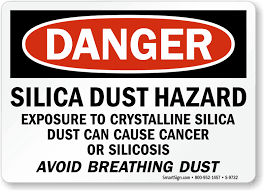
Silica causes permanent lung damage that can be disabling and potentially lead to death. When workers inhale crystalline silica, the lung tissue reacts by developing fibroid nodules and scarring around the trapped silica particles. If the nodules grow too large, breathing becomes difficult.
Silica exposure can cause silicosis and people with silicosis are also at a higher risk of developing tuberculosis. There is no cure for silicosis, but it is 100% preventable. The three types of silicosis are:
- Chronic silicosis, which usually occurs after 10 or more years of exposure to crystalline silica at relatively low concentrations;
- Accelerated silicosis, which results from exposure to high concentrations of crystalline silica and develops 5 to 10 years after the initial exposure; and
- Acute silicosis, which occurs where exposure concentrations are the highest and can cause symptoms to develop within a few weeks to 4 or 5 years after the initial exposure.
Silica and other dusts also cause COPD. COPD includes chronic bronchitis, emphysema, bronchitis, and chronic airway obstruction. In 1999, COPD ranked as the fourth leading cause of death with over 124,000 deaths. COPD is projected to become the third most common cause of death worldwide by 2020.
Symptoms from both silicosis and COPD may not be obvious and can initially include shortness of breath, chest pain, or a persistent cough. Silicosis and COPD can be severe enough to cause respiratory failure, which may eventually lead to death.
Screening & Treatment:
To make sure your doctor is aware that you may have been exposed to silica on the job, and is well informed on the signs, symptoms, and diagnosis of silica related illness, we recommend bringing a Physician’s Alert to your appointment.
Your medical examinations should include:
- Chest x-ray – classified according to the International Labour Office (ILO) International Classification of Radiography for Pneumoconioses
- Pulmonary function test
- Annual evaluation for tuberculosis – Purified protein derivative (PPD) skin test – for everyone with silicosis
There is no specific treatment for silicosis. Workers are advised to avoid further exposures to silica to prevent the disease from getting worse, limit exposure to irritants, and quit smoking. Antibiotics are prescribed for respiratory infections as needed. Those with a positive skin test for tuberculosis (TB) generally need treatment with anti-TB drugs. Any change in the appearance of the chest x-ray may be a sign of TB. Patients with severe silicosis may need to have a lung transplant.
Treatment of COPD includes inhaled bronchodilators, anti-cholinergic agents or steroids, with antibiotics prescribed for respiratory infections as needed. As with silicosis, it is important to limit exposure to irritants and quit smoking.
In 1996, the World Health Organization – International Agency on Cancer Research (IARC) first classified silica as a known human carcinogen and in 2009, IARC reaffirmed its position noting “[an] increased risk of lung cancer [from silica exposure] was observed across various industries and processes.”
The National Cancer Institute completed a study in 2011 showing that lung cancer screening saves lives. Based on that study the American Lung Association recommends lung cancer screening with low-dose CT scans for current or former smokers who are between 55 to 74 years, with a smoking history of at least 30 pack-years (that is, an average of a pack a day for 30 years) and with no history of lung cancer.
Controlling Exposures in Construction While:
Control plan:
Controlling the exposure to silica in construction can be done through engineering controls, administrative actions,& personal protective equipment (PPE),similar to practices in other industries. Engineering controls include such things as replacing silica with another material (substitution), isolating an exposure source, and using ventilation systems. Administrative actions include limiting workers’ exposure time and providing showers. Use of PPE includes wearing proper respiratory protection and protective clothing. The following references aid in controlling crystalline silica hazards in the workplace.
You must implement the best possible permanent solution to reducing or eliminating the hazard. If such a solution cannot be enacted immediately, then you are required to implement a temporary control to protect your workers until the permanent solution is put in place.
The following solutions are listed in order of preference. (Depending on the work site a higher choice may actually be less effective.):

Use a silica substitute
Use engineering controls
Improve work practices
Use personal protective equipment
Silica Substitutes:
The most sure way to eliminate the silica hazard is to eliminate the silica!
This is especially important for sandblasters, where the abrasive blasting is often done outside and in different locations, making it impossible to install an engineering control. The most severe silica exposures occur in abrasive blasting.
Eliminating the silica means using a different, safer material in place of the silica-containing substance. It is true that in some cases it is not possible to use a substitute in place of silica, but for many operations, such as abrasive blasting, there are many possible substitutes, including those below.
Alumaglass Garnet Starblast XL
Aluminum Oxide Glass Beads Steel Grit
Aluminum Shot Melamine Plastic Steel Shot
Ambient Polycarbonate Novaculite Urea Plastic
Armex PC+ Visigrit
Apricot Pits Polycarbonate Walnut Shells
Corn Cobs Silicon Carbide Wheat Grain
Cryogenic Polycarbonate Stainless Cast Shot White Aluminum Oxide
Emery Stainless Cut Wire Zircon
Advantages
- Complete elimination of any health hazard related to silica
- Eliminates the need to implement or maintain engineering controls
- These substances are not as dense as silica products which makes them easier to transport
- They can be moved from job site to job site
Disadvantages
- May be slightly more expensive than silica products
- These substances are generally not as hard as silica products which may mean more is needed to do the job
Engineering Controls:
Keep silica out of the air
- Install a water hose to wet down the dust at the point of generation
- Install local exhaust ventilation
- During rock drilling, flow water through the drill stem
- Install dust collection systems onto machines or equipment that generates dust
- Use concrete/masonry saws that provide water to the blade
Advantages:
- If working properly will eliminate the potential hazard
- Must be installed only once
- Requires little training of workers
- Places no physical burden on workers
Disadvantages
- Can be expensive to implement
- Requires routine maintenance
Work Practices
What employees can do to reduce silica intake
- Know which work operations can lead to silica exposure
- Participate in any air monitoring or training programs offered by the employer
- If possible, change into disposable or washable work clothes at the worksite; shower (where available) and change into clean clothing before leaving the worksite.
- Do not eat, drink, use tobacco, products, or apply cosmetics in areas where there is dust containing crystalline silica.
- Wash your hands and face before eating, drinking, smoking, or applying cosmetics outside of the exposure area.
- If using respirators, do not alter the respirator in any way.
- Use type CE positive pressure abrasive blasting respirators for sandblasting
- For other operations where respirators may be required, use a respirator approved for protection against crystalline silica-containing dust.
- If using tight-fitting respirators do not grow beards or mustaches
Advantages:
- They can reduce the chance for exposure.
- They may be cheaper in the short run.
Disadvantages
- They require training of all new employees.
- They require employees to use the practices appropriately.
- They require monitoring of employees at workers.
Personal Protective Equipment
Personal protective equipment against silica includes respirators and masks. Respirators should be used only when the dust controls cannot keep dust levels below the NIOSH Recommended Exposure Level.
There are many types of respirators, from air-purifying to air-supplying and from a nose and mouth covering to a full body respirator. You can receive guidance on selecting a respirator from:
Advantages:
- They can reduce the chance for exposure.
- They may be cheaper in the short run.
- Useful as a temporary control while the long term solution is being implemented.
Disadvantages:
- They require training of all new employees.
- They require employees to use the equipment appropriately.
- They require setting up a formal PPE program to validate their proper use.
- They require monitoring of all the PPE to insure proper maintenance.
- They can be a health hazard by themselves.
Silica Exposure
Deadly Dust - Silica
Click the below link to download more documents about silica safety

Silica - Occupation health effect
